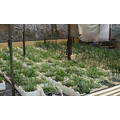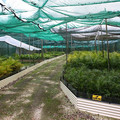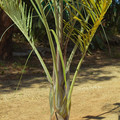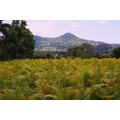Gallery
Click the thumbnails below to view image gallery:Licuala ramsayi ( Wedge Leaflet fan), (Australian Fan Palm)
This is a lovely understory rainforest palm, as a pot plant in cold or temperate areas it would need to be protected but in the sub tropics (Brisbane) it will grow in full sun. It has round tropical green leaves, comes from Nth QLD. With this palm a picture speaks a thousand words.
Hedyscepe Canterburyana (Big Mountain Palm or Umbrella Palm)
This palm can be found on Lord Howe Island off the East Australian coast. They are located on mountainsides or mid to high-level forests. Due to the elevation factor on this plant, it thrives in milder climates than other palms. It has a slow growth rate as evidenced by the trunk rings close together. The frond bases form a somewhat short crown shaft, which is a light bluish gray colour. It grows to a height of up to ten metres.
Archontophoenix Alexandrae (Alexandra Palm)
This is originally from central to northern Queensland. This palm sports handsome mauve flowers just under the crown shaft. It will also produce a number of small red fruits that are about 1.5 cm long and 12 mm in diameter. It is not uncommon for this palm to grow half a metre or more per year. It can grow up to 24 m, the crown shaft can have a base that is about 30 cm, and the bright green fronds can be up to two metres long. This palm has a lighter slightly silver colour under the fronds.
Hydriastele Wendlandiana (Florence Falls Palm or Latrum Palm)
This palm can be found in the Monsoonal Rainforests of NT and Cape York. With its short, flat leaves, it can grow to 20 metres. It thrives in heavy shade and high humidity. It's not really an indoor palm, but can be if it is kept away from fans and air conditioners.
Archontophoenix Cunninghamiana (Bangalow Palm or Piccabean Palm)
These grow in the rainforests of Central Eastern Australia. This palm is similar to the Alexandra Palm, These palms tend to be more damaged by high winds because of the heavier leaves. These palms can do well in both the shade and the sunlight if properly watered. These palms are green in colour under the fronds compared to the Alexandra palm.
Normanya Normanbyi (Black Palm)
These are found in north Queensland. This palm can be as tall as 20m with the fronds reaching 3m in length. It produces white colored flowers and a yellow fruit.
Carpentaria Acuminata (Carpentaria Palm)
This palm grows at the top end of the Northern Territory in flat, lowland areas close to rivers and lakes. It can get as tall as 9m. It produces green to white flowers, and after five to six years produces oval red fruit. It likes partial shade to full sun and moist soil with good drainage. One of the things that make this a great palm is that it has very few diseases.
Ptychosperma Elegans (Solitaire Palm)
This palm also comes from the Northern Territory and the rainforests of Queensland. The Solitaire usually gets about 10m tall. The dark green leaves are pinnate and about 1.8m long. It is fairly tropical and prefers moist well-drained soil. It has also been known to survive mild frosts. This is a single trunked feather leafed palm.
Cocos Nucifera (Coconut Palm)
Found along the eastern coast of Queensland and the western Pacific, the Coconut Palm can reach a height up to 30m. The smooth light gray trunk is ringed with old leaf bases. This palm is highly cultivated for the coconut, coconut oil and coir products that are made from the fibers of the husks.
This palm survives in poor soil, dry conditions and full sun. It handles wind and salt with little problem. However, it does not fare well in cooler conditions and due to its light requirements; it would not make a good houseplant.
Caryota Albertii (Fishtail Palm)
These are found on the eastern coast of Cape York Peninsula. This palm has bi-pinnate leaves, which means twice the pinnate leaves (the tree's pinnate fronds also have pinnate leaflets as well). This gives the palm its fishtail look. This is a fast growing plant that prefers a lot of sun and humidity.
Arenga Australasica (Australian Arenga Palm)
This palm is found along the northern coast of Northern Territory. This is a clump-forming palm that can have up to three dominant trunks and several immature suckers coming from the base. It can be up to 20 m tall with a light gray trunk. It produces yellow flowers and red fruit.
Livistona Australis ( Cabbage Palm)
When young this palm looks like a Rhapis palm and is part of the rainforest along the Australian east coast. There are some good examples at " The Pass" Byron Bay growing amongst the trees.
<< Previous Fussy Palms: How to Choose the Right Palm for Your Climate | Back to Mullumbimby Palm Blog | Next >> Growing Wine Palms (Butia capitata)







